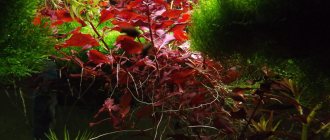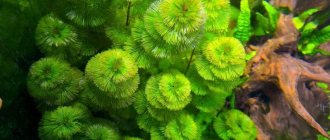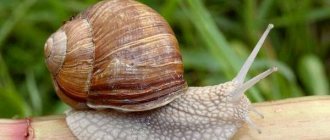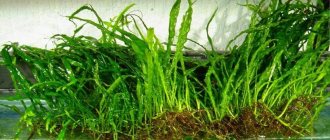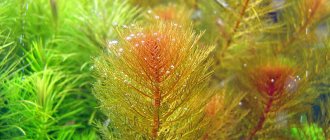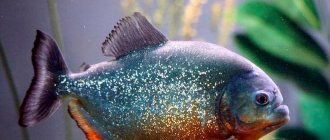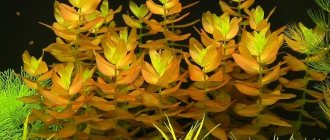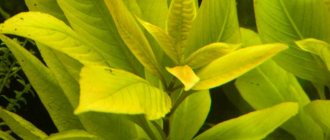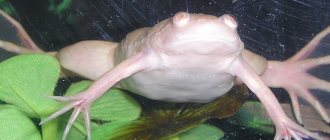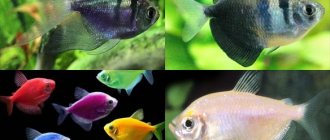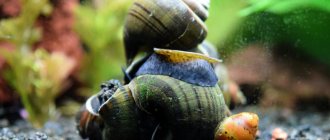Sagittária, or otherwise arrow leaf, is a whole genus of plants from the family Chastukhova. These plants can be found naturally in fresh water bodies of North America.
Neat bright green leaves in the form of a bush, relative unpretentiousness in maintenance, and easy propagation make saggitaria a very attractive plant for aquarists.
Among the aquarium species of saggitaria, the most common are the arrowhead (Sagittaria subulata), the dwarf arrowhead (Sagittaria spec) and the broadleaf arrowhead (Sagittaria platyphylla). The main difference is the width and length of the leaves. The dwarf is the smallest, its leaves have a very decorative size of up to 10cm, the broadleaf is slightly more than 20-40cm, and is also distinguished by its large leaf width. The tallest plant is saggitaria subulate; under good conditions it can reach from 30 to 50 cm in an aquarium; its leaves are narrow and sometimes their length has to be shortened.
Sagittaria in the aquarium and nature
Plants of the genus Arrowhead are mainly distributed in America, where about 30 varieties have been found. In Russia, this figure is much more modest - only three species. And in Africa and Australia, sagittaria was not found at all. Arrow leaf can grow in water, on the banks of reservoirs, in shallow water, in places with a muddy bottom.
Different types of sagittaria are grown especially for home aquariums. They differ in size, but have similar care needs (good lighting, clean water and a well-populated aquarium).
Reproduction
Propagation is quite simple; adult plants produce new runners, which are separated and planted in a new place.
In aquadesign, you can create a green carpet using sagittaria. In this case, the sagittaria needs to be planted several bushes at a time at a distance of 4-5 cm from each other. Therefore, it is suitable for planting in the foreground. It is also often planted in nano aquariums, but in small aquariums it can be grown as a background plant, since the plant actively grows and fills the free space both in height and width. The arrowhead also gets along well with its neighbors, for example glossostigma, Anubias berteri and many others.
What does sagittarium look like?
The genus unites perennial plants, which are characterized by:
- short, tuberous or knotty, well-developed white rhizomes;
- in underwater forms, the leaves are braid-shaped or petiolate with a small heart-shaped or elliptical plate floating on the surface of the water;
- Amphibian forms have leaves of three categories:
under water - braid-like without petioles, on the surface - floating, with petioles, with a plate in the shape of an egg, heart or arrow, above water - with a strong petiole, in the form of an arrow or spear; - all the foliage is bright green, juicy, fleshy, with a clearly defined vein in the middle.
- flowers with wide white petals and small green sepals are collected in racemose inflorescences on stalks rising above the water.
We can say that Sagittaria is similar to Vallisneria, but it is more powerful, and the leaves are shorter, wider and more curved.
Useful lifehacks
So that you do not have problems growing this crop, we bring to your attention the advice of experienced aquarists:
- Aquarium sagittaria on sale are sometimes replaced by plants of similar shape that are not adapted to life under water. But most often it is confused with some species of Vallisneria and Echinodorus gentle. As for Vallisneria, you need to distinguish by size - sagittaria bushes look more voluminous, and the leaves are shorter. The situation with Echinodorus is more complicated. This plant also belongs to the Chastukhov family, and it is difficult for an inexperienced aquarist to systematize these 2 plants. It is important to remember that Sagittaria has folded leaves, while Echinodorus does not, and its leaf blades are thinner and more luscious green in color. If assessed tactilely, then the arrowhead foliage is rougher to the touch. You can also distinguish by the speed of growth - the sagittaria grows 2 times slower.
- After transportation, it is advisable to place the plant in a densely populated herbal garden.
- When planting, make sure that the root collars remain above the surface of the substrate.
- In bright light, the leaves of the sagittaria become lighter.
- All types of arrowhead react negatively to low concentrations of iron in the aquatic environment. The indicator is the color of the leaves. If they turn yellow, the content of this element should be increased.
- Side lighting leads to deformation of the shape of the bushes, so overhead light is preferable.
- If a plant grows rapidly upward and sheds its leaves, it does not have enough light.
Content
Keeping dwarf sagittaria is relatively easy; it is one of the few plants that tolerates highly alkaline and hard water, although it is better to stick to average values of hardness and acidity. Just like all ground cover plants, it prefers very fine soil rich in nutrients, or with the addition of clay, or fertilizers must be constantly added to the water. Sagittaria is particularly intolerant of low iron levels, and if you see yellowed leaves of the plant, it means there is an iron deficiency in the aquarium.
Sagittaria dwarf will appreciate the additional introduction of CO2 into the aquarium, however, even without the addition of carbon dioxide, this aquarium plant will feel great. If CO2 is not introduced, then it is advisable to increase the lighting of the aquarium to stimulate plant growth.
For dwarf sagittaria, only moderate lighting is enough, but strong light is still better. If the lighting is strong, then after quite a long time the leaves of the plant turn red.
Ideally, an arrowhead aquarium should use bright fluorescent lamps, T5 or T8, with a power of at least 0.75 watts per liter of water, but the plant will feel better with more powerful lighting. LED lights and lamps can also be used, but they must be bright enough, and all commercially available LED lights are rated for plants with low light requirements. It’s another matter if you use a lamp assembled by yourself from correctly selected LEDs, or combine LED strips with fluorescent lamps.
The water temperature should be between 18 and 26°C, although the plant can temporarily tolerate temperature fluctuations between 15°C and 29°C.
In order for sagittaria to feel good, you need to regularly add liquid fertilizers to the water, both macro and micro fertilizers, including iron.
The plant requires periodic pruning. Since the runners are quite close to each other, the leaves will reach towards the light, growing quite tall.
Eaton's arrowleaf
Sagittaria eatoni
One of the most beautiful arrowheads, forming a rosette of light green leaves with rounded tips curving downwards. Plant height is 15-20cm. It can be kept in an aquarium of any size. Grows evenly throughout the year.
The plant is suitable for keeping in tropical and moderately warm aquariums. The optimal temperature is 20-26°C. In colder water, growth slows down and the plant becomes noticeably smaller. Hardness and the active reaction of water do not have a significant effect on the growth of arrowhead; it grows almost equally in very soft water at a pH of about 5.5 and in hard water at a pH of about 8. It is necessary to monitor the purity of the water. In turbid water with a large amount of suspended organic particles, the delicate leaves of arrowhead become covered with plaque and quickly collapse. Therefore, you need to change up to 1/5-1/4 of the water every week, and also ensure its effective filtration.
The sagittaria is not very demanding on lighting, but the nature of its growth depends on the brightness of the light. In low light, the plant begins to stretch upward and loses its original shape. With sufficiently bright light, the leaves become wider and arch, due to which the plant acquires its unique shape. Light should only be directed from above. Side lighting is undesirable, as it deforms the bush. Natural light does not have any advantages over artificial light, so the plant can be illuminated in any way. For artificial lighting, both fluorescent lamps and incandescent lamps can be used. The approximate power of fluorescent lamps should be at least 0.4 W per 1 liter of volume, the power of incandescent lamps should be three times higher. The length of daylight, depending on the brightness of the lighting, can range from 10 to 14 hours.
The plant develops a fairly strong root system, but its roots are very delicate and brittle. The soil should be nutritious and well silted. When planting sagittaria in new soil, a piece of clay or silt taken from an old aquarium should be placed under the roots. Coarse sand or small pebbles should be used as a substrate. The thickness of the soil layer should be large enough - at least 5 cm.
Mineral feeding of sagittaria is very useful, especially during the breeding season. You can use any complex mineral fertilizers with microelements at a dose of 1.5-2 g per 100 liters of water.
In an aquarium, Sagittaria reproduces vegetatively, forming daughter plants on ground shoots. After the formation of 5-6 leaves, the daughter plants can be separated from the mother thicket and transplanted to a new location. The tissues of the sagittaria are porous and contain a supply of oxygen, so when transplanting the plant must be well secured in the ground with pebbles or glass pins so that it does not float up.
Just as successfully as in an aquarium, the plant can be grown in a paludarium - in flooded soil. In sunlight and a temperature of 26-30°C, the plant blooms and can form full-fledged seeds. Sown in a bowl of sand filled with water, the seeds germinate at a temperature of 26-28 °C. Further cultivation of seedlings does not present any great difficulties.
Types of sagittariums
Dwarf Sagittaria is a low-growing bushy plant. The height of the thickets is no more than 10 cm. The photo shows a thick “carpet” of Sagittaria dwarf, as in the photo. The soil should be fine-grained with moderate silt content. Loves light, but is undemanding to temperature conditions. Water quality is practically irrelevant. However, cloudy water will cause plaque to appear on the leaves. It is necessary to maintain cleanliness in the aquarium, then the dwarf sagittaria will grow evenly all year round. Sagittaria propagation of this species is quite simple: the plant throws out daughter shoots, which should be planted.
Subulate Sagittaria (or subulata) is a plant up to 15 cm in height. It looks like a rosette with leaves and a bulbous rhizome coming out of it. Under favorable conditions it can bloom. In the photo, the arrowhead has already grown quite large in the aquarium. The soil chosen is fine and nutritious, for example, small pebbles or coarse sand. The illumination should be bright, up to exposure to direct sunlight. Daylight hours are at least 12 hours. Such sagittaria reproduces with the help of shoots on which daughter plants are formed.
Rigid-leaved Sagittaria is the most powerful plant of this class. The roots are large and firmly anchored in the soil. You can usually see in the photo that the arrowhead is quite spreading. The soil should be granular with some inclusions and silt. Sagittaria of this species is not demanding on temperature conditions, but it grows better alone. If there are other plants nearby, then it develops poorly and loses its decorative appearance.
Sagittaria loves bright lighting, which can be either natural or artificial. The water should be kept clean and care should be taken to ensure daylight hours (at least 10 hours). Otherwise, arrowhead is unpretentious and can become a real decoration for any aquarium.
Types of plants with photographs
There are many more different species that differ only in the size and length of the leaves. At the same time, caring for them is exactly the same.
Subulate arrowhead
A subspecies that is found in South and North America. Most often it grows in shallow, stagnant water. This species is characterized by the fact that it can bloom in an aquarium. In such cases, the inflorescences have several small white flowers. In this case, the peduncle brings the upper flowers to the surface of the water.
Very often this type of plant changes into another species. It depends on the growing conditions. This species can be used in any aquarium. In this case, the water temperature does not play a special role.
The plant does not need special lighting, but weekly changes of water and proper soil are mandatory. The best option would be a shallow, slightly silted substrate.
The plant needs regular replanting. The rosette must be separated extremely carefully when the arrowhead has formed more than 4 leaves with separate roots.
Arrowhead subulate
Dwarf arrowhead
It is considered low-growing, but in an aquarium it can form strong thickets and intertwine with other plants. Bushes usually do not grow more than 10 centimeters.
Experts recommend planting it separately from other species, preferably near the front wall of the aquarium. In this case, the volume of the aquarium can be quite small.
Editorial: Indian ocellated knife
The plant is easy to care for and is perfect for beginners, as it is unpretentious to temperature and water quality. But the aquarium must have a filter; this will protect the algae from yellowing and dying. Lighting should be moderate and not too intense. It is enough to use ordinary incandescent lamps.
In order for the plant to grow well, you should pay attention to the selection of soil. It can be fine sand and organic matter
Arrowhead dwarf
Arrowhead rigidifolia
Sagittaria of this species comes from Central America. Its leaf blades are short, slightly curved, and wide. They have a pointed shape and look quite massive. The root system is white and very powerful. The leaves are bright green, with a vein visible in the middle. This variety of arrowhead is characterized by frequent, long-term flowering. There are more than 20 flowers on one bush.
Experts recommend growing this species in a mixture of sand and silt. The plant grows well in a warm aquarium with natural light. It is worth remembering that arrowhead needs to be planted away from other plants, as it does not like neighbors and in such cases does not grow well.
Sagittaria latifolia
Not a very common plant. In nature, it lives in America, Asia and some parts of Europe. It will be an excellent addition to an aquarium or aquaterrarium. It grows up to 25 centimeters, is not particularly whimsical and takes root well.
This species is characterized by the fact that it adapts to any growing conditions. At the same time, it grows better in loose soil. It needs to be planted separately from other plants and given more free space around.
In small aquariums it grows on average up to 15 centimeters. You can trim the ends and replant the plant.
Arrowhead
Important points
- The light should only come from above. But side lighting is undesirable, as it leads to deformation of the shape of the sagittaria bush.
- Mineral feeding will not be superfluous, especially during the breeding season. Its approximate dosage is 1.5-2 g per 100 liters of water.
- Planting of all types of sagittariums must be done very carefully, without burying the plant necks in the sand, but leaving them above the surface.
In conclusion, this is an ideal plant for beginners: beautiful and easy to care for. And among the variety of species, everyone can choose a plant to suit their taste.
DISEASES OF AQUARIUM PLANTS AND THEIR CAUSES
METHODS OF GROWING AQUARIUM PLANTS
PROPAGATION OF AQUARIUM PLANTS
Description
It has fleshy leaves of a dark green color collected in a rosette; a pronounced vein runs down the center of the long leaf. It can grow up to 50 cm in height, but the leaf width does not exceed 0.5 cm. Among aquarium enthusiasts and on sale, the plant is often called arrowhead. It received this name because of its sharp and long leaves, similar to an arrow (sagitta).
Diseases
Aquarium plants such as Sagittaria often get sick due to violations of their maintenance conditions. Thus, inhibition of the growth of this species develops due to a deficiency of potassium and sulfur, high acidity of water and lack of light. Improving the circulation of aquarium moisture will help cure the plant.
Another common disease is necrosis. It is caused by a deficiency of vitamins such as calcium and boron. However, it can also occur due to excess nitrates in the water. It is not difficult to detect tissue death if you know that the disease first affects new leaves.
Sagittaria may also experience chlorosis. It is characterized by the disappearance of chlorophyll. This disease is caused by a deficiency of iron and copper, nitrogen and molybdenum, and nutrients such as sulfur and boron. Another reason for the development of the disease is the accumulation of phosphates in parts of the plant. It can be identified by brown spots on photosynthetic organs; the disease more actively affects older leaves. Moreover, they usually do not fall off.
Plants from the same family:
- Echinodorus palaefolius
- Echinodorus aschersonianus
- Echinodorus bleheri or paniculatus
- Echinodorus horemanii
- Amazonian Echinodorus (Echinodorus amazonicus or brevipedicellatus)
- Echinodorus major or Bart (Echinodorus major or martii)
- Echinodorus verticalis
- Echinodorus horizontally
- Speckled Echinodorus (Echinodorus aspersus)
- Echinodorus latifolius or xingu or magdalenensis
- Echinodorus parviflorus
- Echinodorus tender or grassy Echinodorus (Echinodorus tenellus)
- Echinodorus osiris or Echinodorus rubra
- Echinodorus mucronatum
- Echinodorus sellovianus
- Echinodorus cordifolia (Echinodorus cordifolius or Echinodorus radicans)
- Echinodorus angustifolius
Sagittaria subulata
Sagittaria subulata is a popular aquarium plant. Forms a rosette of narrow ribbon-shaped leaves, the color of which is green or green-brown. The height of the leaf plates reaches 15 cm in length. Reproduction occurs by dividing the basal side shoots; in a short time, a lush bush will form in the aquascape, which will create dense green thickets. Subulate sagittaria comes from freshwater bodies of North and Central America and can grow in brackish water.
This type of sagittaria prefers to be kept in oily soil with a fine fraction, saturated with useful components. The plant loves bright light with direct sunlight (at least a few hours a day). The recommended daylight hours are 10-12 hours. Permissible temperature in water: 20-26 degrees Celsius, although it can tolerate changes in the temperature range by +-10°C. It can develop in hard or soft water, pH neutral or slightly acidic. Does not like silty soil and large amounts of suspended particles in the aquatic environment.
Editorial: Aquarium cherry
Sagittaria spec
Dwarf sagittaria (lat. Sagittaria spec) is a perennial plant of the Chastukhov family. Came to our country from the Netherlands in the 80s of the twentieth century. The plant is low (8-10 cm in height), characterized by thin leaves, and can grow throughout the year. Can be kept in a tank of any capacity, planted near the front glass of the aquarium. This is an unpretentious plant, so it is perfect for beginners in aquarium keeping.
Look at an aquarium with a sagittaria.
What conditions need to be provided for the dwarf sagittaria:
- The plant develops well at a water temperature of 18-28 ° C, and can tolerate a decrease to 14 degrees. Can adapt to neutral or slightly acidic pH water, any hardness. It does not like dirty and muddy water, since dirt can quickly form a coating on its leaf plates. It is recommended to filter the water and replace 25% of the water with clean water once a week. Silt in the ground must be removed using a funnel in the siphon.
- Dwarf sagittaria loves moderate lighting, which can be provided with 0.5 Watt fluorescent lamps or sunlight. With a lack of light, the bush thins out and the leaves become pale.
- The soil of a fine fraction is suitable as a soil; it can be moderately silted sand with a layer thickness of 2-3 cm. In a substrate of a coarse fraction, the sagittaria will not be able to spread evenly along the bottom of the coating.
- Dwarf arrowhead reproduces vegetatively. Daughter plants and cuttings are separated from the mother bush and transplanted to another place. They can also be grown in a humidified greenhouse, where there is bright lighting and an air temperature of 24-30 ° C.
Arrowhead rigidifolia
Stiff-leaved sagittaria, or rigid-leaved arrowhead, also comes from the waters of South and Central America. The leaf blades are short, curved, slightly wide, and have pointed ends. The root system is well developed, the rhizomes are white.
The color of the leaves is bright green, the texture of the leaves is fleshy and juicy, and there is a vein running down the middle of the leaf. The best soil is sand with a fraction of 3 mm with silt. The water temperature can be 24 degrees Celsius, suitable for tropical aquariums. The rigid-leaved sagittaria does not welcome other plant species nearby and can grow independently, forming a lush bush. It may not grow well in the vicinity of other plant species.
